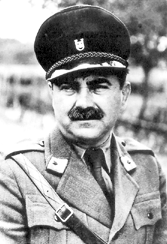
Defenders claim he was an accomplished author who served as “Minister of Culture” of the Independent State of Croatia. Mile Budak was also Minister of Religion, Education and Cults, and his signature is at the bottom of some of the most infamous decrees of the Ustase regime, and provided the Ustase’s ideological backbone as a Goebbels-style propagandist. Uttered that the goal of the Ustase regime was to “kill a third, expel a third, and convert a third” of the Serbian population. Also initialed the anti-Semitic measures introduced within days of the Ustase taking power in April, 1941. Born in Sveti Rok (Saint Rocco) 1889 and trained as a lawyer. Recognized as a writer of middling originality and imagination, primarily from his poetry and short stories and later his novels such as The Hearth. Attacked by militants of the pro-Serb “Young Yugoslavia” organization in broad daylight in June 1934. The assault fractured his skull and shortly thereafter he went abroad, joining the Ustase. Named doglavnik (deputy leader) of the NDH and placed in charge of preserving and translating Ustase ideology to Croats. His belief that Muslims and Croats were the same people who held different religions was accepted by most other Ustase leaders (though Serbs he considered “wandering beggars from the East whom the Turks brought along as servants and porters.”) As the NDH’s chief cultural figure, tried to persuade artists and writers to support the new regime with varying degrees of success. The great Croat novelist Miroslav Krleza lampooned Budak as “a minister of culture with a machine gun,” and sculptor Ivan Mestrovic was imprisoned for several months after he came to Zagreb not to make busts of the poglavnik but to ask Budak for a passport out of the country. The Independent State of Croatia Budak’s position was made redundant once the Jewish and Roma problems in the NDH were “solved” by their extermination, and he was shuffled around to other positions, including Foreign Minister. Eventually fell out of favor following the internal strife within the NDH government involving the Kvaterniks. Made a trip to Rome and greatly impressed Ustasha supporters at the Vatican. One of the few Ustasha political leaders captured after the war and executed in 1945.